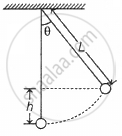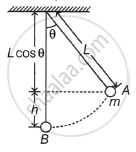Advertisements
Advertisements
Question
A simple pendulum with a bob of mass m and conducting wire of length L swings under gravity through an angle θ. The component of the earth's magnetic field in the direction perpendicular to the swing is B. Maximum emf induced across the pendulum is ______.
(g = acceleration due to gravity)

Options
`BL sin(theta/2)(gL)`
`2BLsin(theta/2)(gL)^{3"/"2}`
`2BLsin(theta/2)(gL)^2`
`2BLsin(theta/2)(gL)^{1"/"2}`
Solution
A simple pendulum with a bob of mass m and conducting wire of length L swings under gravity through an angle θ. The component of the earth's magnetic field in the direction perpendicular to the swing is B. Maximum emf induced across the pendulum is `underlinebb(2BLsin(theta/2)(gL)^{1"/"2})`.
Explanation:
When the bob reaches point B from point A as shown below, then the vertical height travelled by the bob,
h = L - L cosθ
⇒ h = L(1 - cosθ)

The velocity of the bob at point B is v and at A is u, which is zero at the extreme point, i.e. u = 0 then from the equation,
v2 = u2 + 2gh
∴ v2 = 2gh = 2gL(1 - cosθ) = 2gL(2sin2θ/2) [∵ 1 - cosθ = 2sin2`theta/2`]
⇒ v = `2sqrt(gL)sin theta/2`
Thus, maximum emf induced,
`e_{max} = B"v"L = B xx 2sqrt(gL)(sin theta"/"2)L`
= 2BL(sinθ/2)(gL)1/2
